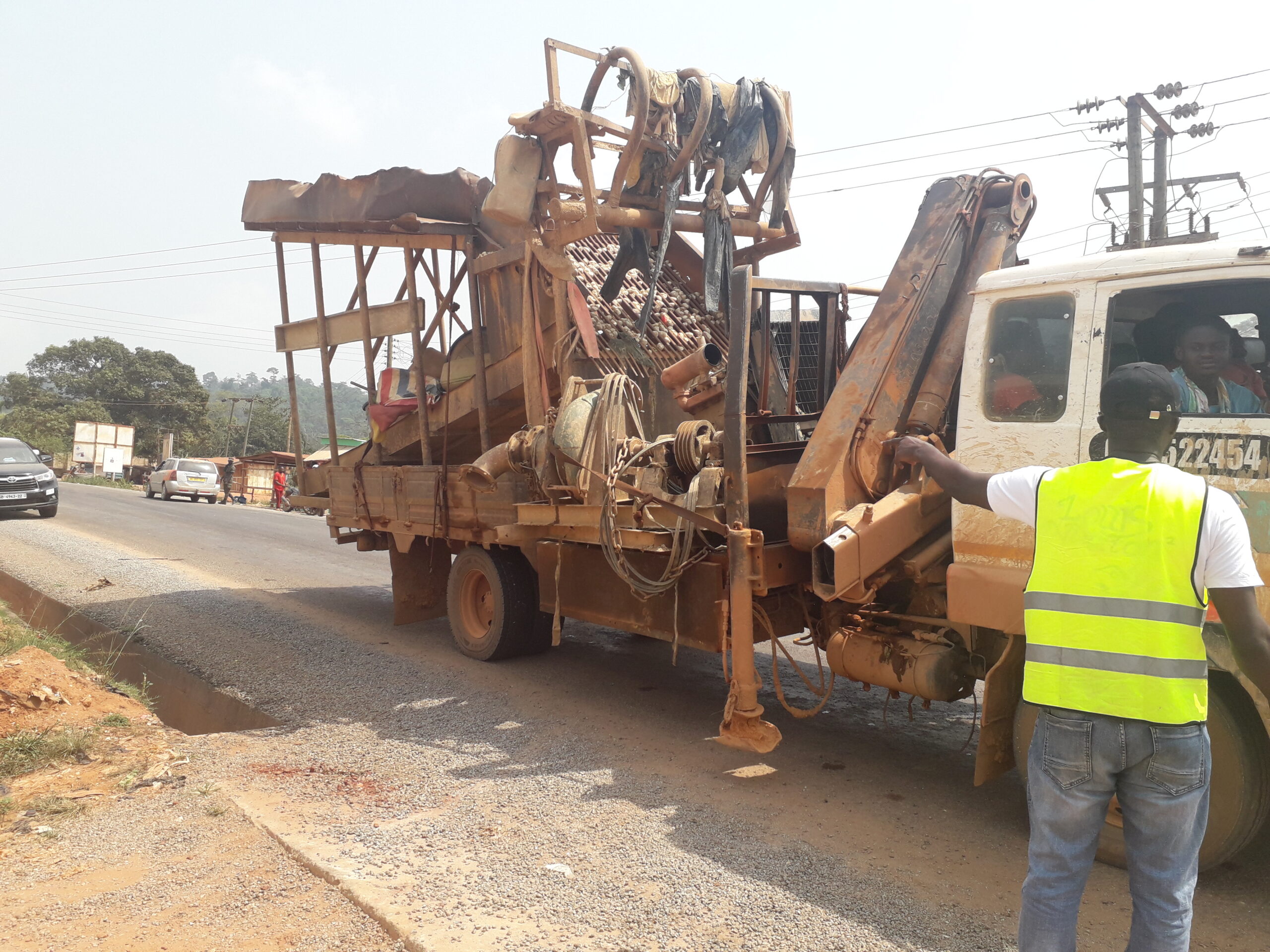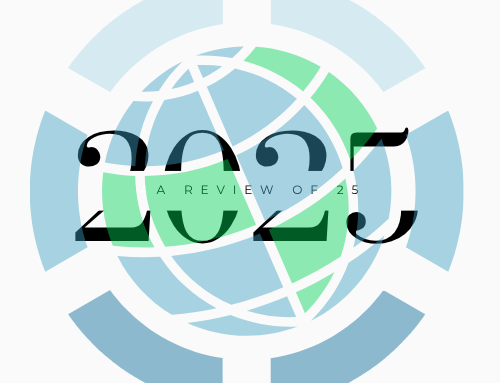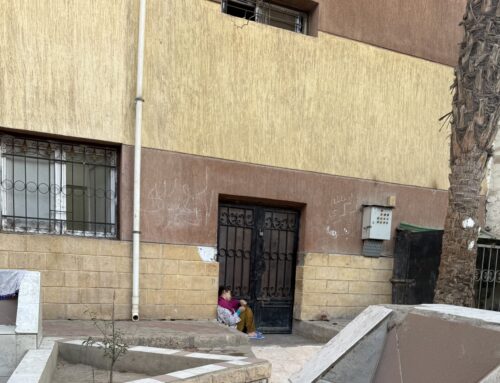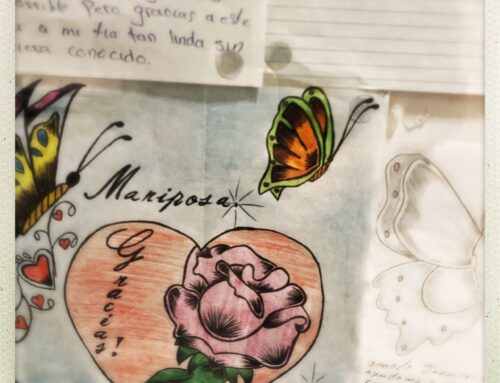
Transport of equipment for illegal small-scale mining at Kenkyere Barrier, Ghana. Photo by H.A. Agyekum
Although bordering practice is often accompanied by militarized security and violence, in a nonetheless highly securitized context—that of “illegal” goldmining in Ghana’s Ashanti Region—the country’s approach focuses on monitoring, rather than preventing movement within and across its borders. Every year, thousands of migrants from Ghana’s northern regions as well as from Sahelian countries, especially Burkina Faso, migrate to Ghana to seek work in the illegal goldmines and beyond. Even as the Ghanaian state encourages such mobility, it also aims to regulate it due to concerns over growing jihadism in the Sahel region. The regulation effort is complicated by a longstanding open borders policy for West African citizens from the Economic Community of West African States (ECOWAS) zone.
The following is a scene I witnessed at an immigration station in Ghana’s Ashanti Region:
Kenkyere Barrier, Amansie South District, 18 January 2024
Kenkyere Barrier, an inland district border, is about 500 meters from the local government office complex of the Amansie South District, Ashanti Region. The offices are on a hilltop, while the barrier manned by Ghana Immigration officers is in a valley, making it impossible for incoming vehicles—filled with northern migrants moving south—to escape the barrier. I sat with civil servants and immigration officers for five hours, to observe the goings-on in an area considered the hub of illegal mining in the region. “We are at the entry point to the mining areas,” said Mr. R, a civil servant.
Most of the vehicles passing through the barrier were waved on. Occasionally, Mercedes Benz Sprinter minibuses were stopped and the passengers instructed to disembark. On one occasion, 10 Burkinabes and 2 Malians were on board. The Immigration Officer inspected their papers. After deliberations for about half an hour, the passengers were allowed to proceed. After this encounter, the Commander responsible for the post explained: “You know because of the problems in Burkina Faso [extremist violence], we have a lot of refugees up North [in the Northern regions of Ghana]. Some of them take advantage of their refugee status to get into mining. The camp is large so it is not easy to keep tabs on everyone. So, they leave one by one. If one finds a place that favors him, he will tell his brother, who will leave and join him. Before you realize, a whole group of men have disappeared from the camp into the countryside, with many finding their way to southern Ghana.” He continued: “There is not much you can do against that because of ECOWAS [open border] agreements. They are allowed to come to Ghana for a visit and stay for 90 days. But if the person is coming to work, he needs a work permit, valid for a year. When we stop Burkinabes, they are usually refugees and you can’t tell whether or not they are going to go into mining. But since this is the entry point to one of Ghana’s main mining areas, we conduct these inspections. We stop a lot of Malians and Nigeriens. They are not here to mine, but to sell herbal medicines or clothes, but we don’t send them back.” Compared to Burkinabes, Malian and Nigerien migrants are just passing through Ghana, minding their own business and with no intention of engaging in illegal mining activities.
Galamsey as a vector of migration
Gold mining in Ghana has historically shaped social, economic and political life (Pijpers 2020; Plange 1984). Due to the 1980s World Bank’s Structural Adjustment Programs, Ghana experienced a rapid and ongoing upsurge in large-scale as well as informal artisanal small-scale mining (ASM), or galamsey, which according to Ghana’s mining laws is “illegal.” Today, galamsey is estimated to directly employ around one million people, with up to 4.5 million indirectly employed. Environmental and civil society groups have increasingly called for restrictions because artisanal mining contaminates land, waterbodies, and air, leading to serious health effects including increased cases of kidney disease and birth defects in galamsey communities (Gibb and O’Leary 2014).
Galamsey has influence over Ghanaian electoral outcomes due to its devastating effects on the environment and water quality. Further, the influx of migrants from Burkina Faso engenders fears of a jihadist invasion. Even so, due to ECOWAS’s open border policy and the need for mining labor, security concerns are often overlooked. As a result, border officials attempt to discriminate by deciding who to allow and who to refuse entry, based on suspicions of ability and willingness to engage in illegal small-scale mining activities. Such dynamics, I suggest, shed light on what some of the literature has characterized as the securitization and militarization of the border (Álvarez & Urbina 2018). In contrast, I argue, the Ghanaian state does not militarize migration mobility either within or across its borders. Instead, Ghana’s bordermaking approach pragmatically monitors the movement of goods and persons.
Two arguments explain the absence of militarization in the nevertheless highly securitized context of galamsey. Galamsey is a major vector of internal labor mobility in Ghana, and also attracts mining labor from neighboring countries. These movements, initiated during colonialism, unfold in extant social networks that render such migration flows “normal.” Although colonial North-South labor mobility was often forced, today such migration to illegal mining sites is largely voluntary.
Contemporary security dynamics in the Sahel and parts of West Africa, which assert that extremist violence is descending from the Sahel to the Gulf of Guinea, add further complexity to Ghana’s bordermaking efforts. Despite these security concerns, Ghana’s bordering practices are not geared towards securitizing or militarizing people’s movements. Malians, Nigeriens and Burkinabes travel through, across and within Ghana. As ECOWAS citizens, their movements cannot be restricted, as noted by the immigration officer. Militarized border security is typically designed for mass control. In contrast, Ghana’s bordermaking approach monitors movements within and across its borders aimed at preventing Burkinabes from engaging in illegal economic activity, but also to detect “terrorists” on the red alert notice issued by security and intelligence agencies.
In sum, Ghana maintains an instrumental approach to the movement of its people and that of migrants from neighboring countries. Immigration officers are careful not to securitize the mobility of migrants moving through Ghana. Although they are aware that given the opportunity migrants will engage in illegal mining, to the officers, this mobility is not a security issue, but rather folds economics into the bordering regime.
References
Álvarez, Sofía Espinoza and Martin Guevara Urbina. 2018. Immigration and the law: Race, citizenship, and social control. The University of Arizona Press.
Gibb, Herman, and Keri Grace O’Leary. 2014. “Mercury exposure and health impacts among individuals in the artisanal and small-scale gold mining community: A comprehensive review.” Environmental health perspectives 122 (7): 667-672.
Pijpers, Robert Jan. 2020. “Ghana: A history of expansion and contraction.” In Global Gold Production Touching Ground: Expansion, Informalization, and Technological Innovation, edited by Boris Verbrugge and Sara Geenen. Palgrave MacMillan.
Plange, Nii K. 1984. “The Colonial state in Northern Ghana: The political economy of pacification.” Review of African Political Economy 11 (31): 29-43.
Acknowledgements
This work was supported by the Independent Research Fund Denmark under grant number 1127-00226B.
Humphrey Asamoah Agyekum is an Assistant Professor at the Centre for Global Criminology, Department of Anthropology, University of Copenhagen, Denmark. He currently works on a project on illegal mining in Ghana. He is the author of From Bullies to Officers and Gentlemen: How Notions of Professionalism and Civility Transformed the Ghana Armed Forces (2019), published by Berghahn Books. His other scientific output has appeared in leading academic journals, such as Armed Forces & Society, Africa, Critical Military Studies, Social Science and Medicine, and Africa Spectrum.
Cite as: Agyekum, Humphrey Asamoah. 2025. “Complicating Cross-border Mobility in Ghana”. In “Bordering and the War on Migration”, edited by Anna Simone Reumert, Wendy Vogt, and Charlie Piot, American Ethnologist website, 23 September 2025. [https://americanethnologist.org/online-content/complicating-cross-border-mobility-in-ghana-by-humphrey-asamoah-agyekum/]
This piece was edited by American Ethnological Society Digital Content Editor Kathryn E. Goldfarb (kathryn.goldfarb@colorado.edu).




